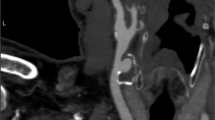Abstract
Purpose
The superficial temporal artery (STA) is one of the terminal branches of the external carotid artery; STA pseudoaneurysms are uncommon vascular lesion, generally subsequent to blunt or penetrating trauma that could represent a trick for radiologist, especially when the only anamnestic information is “palpable superficial swelling”. In this article, we describe our ultrasonographic experience about STA pseudoaneurysm reporting several cases with different etiopatogenesis.
Methods
Between January 2004 and March 2015 six patients (4F and 2M; aged 15–55 years, mean 36 year) presented at our department with superficial palpable swelling in temporal region (four with trauma history, two with iatrogenic cause) underwent to ultrasonographic study to assess the presence of STA pseudoaneurysm. Ultrasonographic findings suggestive of pseudoaneurysm was a well-defined, pulsatile, anechoic mass in B-mode, a swirling or disorganized pattern of blood flow in the lesion with demonstration of direct communication between arterial lumen and pseudoaneurysm at colour-Doppler and a typical to-and-fro waveform on pseudoaneurysm neck at pulsed-Doppler.
Results
B-mode proves the presence of anechoic mass in five on six patients. Colour-Doppler demonstrates the presence of flow inside the lesion in five patients and a direct communication in all patients. To-and-fro typical waveform has been demonstrated in five patients. Ultrasound made diagnosis in all patients with a sensibility and specificity of 100 %.
Conclusion
US is the imaging modality of choice, since it can provide detailed information about vascular anatomy without incurring the risks of invasive methods like angiography or radiation.
Riassunto
Scopo
L’arteria temporale superficiale (STA) è uno dei rami terminali della carotide esterna. Gli pseudoaneurismi dell’STA sono poco frequenti, generalmente successivi a traumi chiusi o penetranti, potendo trarre in inganno il radiologo soprattutto quando l’unica informazione anamnestica è “rigonfiamento superficiale palpabile”. In quest’articolo descriviamo la nostra esperienza ultrasonografica riguardo gli pseudoaneurismi dell’STA riportando diversi casi ad eziopatogenesi diversa.
Metodi
Tra il Gennaio 2004 e Marzo 2015 6 pazienti (4F E 2M; Età 15–55 anni, media 36) giunti al nostro dipartimento per un rigonfiamento superficiale palpabile in regione temporale (4 con storia di trauma, 2 per cause iatrogene) vengono sottoposti ad esame ecografico per valutare la presenza di pseudoaneurismi dell’STA. I reperti ultrasonografici suggestivi per pseudoaneurisma sono stati: una massa ben definita, anecogena e pulsatile in B-mode, un pattern di flusso turbolento all’interno della lesione con la dimostrazione di una diretta comunicazione tra il lume arterioso e lo pseudoaneurisma al color-Doppler e un tipico spettro flussimetrico “to-and-fro” in corrispondenza del collo aneurismatico.
Risultati
B-mode ha mostrato la presenza di una massa anecogena in 5 su 6 pazienti. Il color-Doppler ha dimostrato la presenza di flusso all’interno della lesione in 5 pazienti e una diretta comunicazione in tutti i pazienti. Lo spettro “to-and-fro” è stato dimostrato in 5 pazienti. L’ecografia ha permesso la diagnosi in tutti i pazienti con una sensibilità e specificità pari al 100 %.
Conclusioni
L’ecografia rappresenta la modalità di imaging di scelta, fornendo informazioni dettagliate sull’anatomia vascolare senza incorrere nei rischi di metodiche invasive come l’angiografia o all’utilizzo di radiazioni.



Similar content being viewed by others
References
Bartholin T (1644) Epistolarium medicinalum centuria. Comitum, The Hague, p 53
Conner WC 3rd, Rohrich R, Pollock R (1998) Traumatic aneurysms of the face and temple: a case report and literature review, 1644–1998. Ann Plast Surg 41:321–326
Stapleton CJ, Fusco MR, Thomas AJ, Levy EI, Ogilvy CS (2014) Traumatic pseudoaneurysms of the superficial temporal artery: case series, anatomy, and multidisciplinary treatment considerations. J Clin Neurosci 21(9):1529–1532. doi:10.1016/j.jocn.2014.02.004
Goksu E, Senay E, Alimoğlu E, Aksoy C (2009) Superficial temporal artery pseudoaneurysm: ultrasonographic diagnosis in the ED. Am J Emerg Med 27(5):627. doi:10.1016/j.ajem.2008.08.024
Han K, Borah GL (1996) Pseudoaneurysm of the anterior superficial temporal artery. Ann Plast Surg 27:650–653
Pinar YA, Govsa F (2006) Anatomy of the superficial temporal artery and its branches: its importance for surgery. Surg Radiol Anat 28:248–253
Kumar V, Abbas KA, Aster CJ (2015) Robbins and Cotran pathologic basis of disease, 9th edn. Saunders Edition, London
Walker MT, Liu MT, Salehi SA, Badve S, Batjer HH (2003) Superficial temporal artery pseudoaneurysm: diagnosis and preoperative planning with CT angiography. AJNR Am J Neuroradiol 24(1):147–150
Lin K, Matarasso A, Edelstein DR, Swift RQ, Shnayder Y (2004) Superficial temporal artery pseudoaneurysm after face lift. Aesthet Surg J 24(1):28–32. doi:10.1016/j.asj.2003.10.008
Mahmoud MZ, Al-Saadi M, Abuderman A, Alzimami KS, Alkhorayef M, Almagli B, Sulieman A (2015) “To-and-fro” waveform in the diagnosis of arterial pseudoaneurysms. World J Radiol 7(5):89–99. doi:10.4329/wjr.v7.i5.89
Kapoor BS, Haddad HL, Saddekni S, Lockhart ME (2009) Diagnosis and management of pseudoaneurysms: an update. Curr Probl Diagn Radiol 38(4):170–188. doi:10.1067/j.cpradiol.2008.11.001
Author information
Authors and Affiliations
Corresponding author
Ethics declarations
Human and animal rights
All ethical procedures performed in studies involving human participants were in accordance with the ethical standards of the institutional and/or national research committee and with the 1964 Helsinki declaration and its later amendments or comparable ethical standards.
Informed consent
All patients provided written informed consent to enrolment in the study and to the inclusion in this article of information that could potentially lead to their identification.
Conflict of interest
The authors declare that they have no conflict of interest.
Rights and permissions
About this article
Cite this article
Corvino, A., Catalano, O., Corvino, F. et al. Superficial temporal artery pseudoaneurysm: what is the role of ultrasound?. J Ultrasound 19, 197–201 (2016). https://doi.org/10.1007/s40477-016-0211-8
Received:
Accepted:
Published:
Issue Date:
DOI: https://doi.org/10.1007/s40477-016-0211-8




